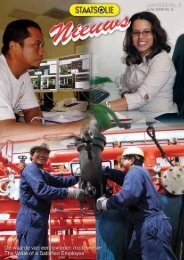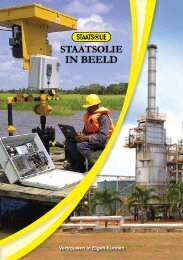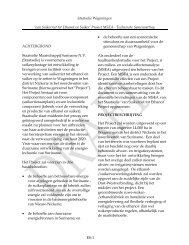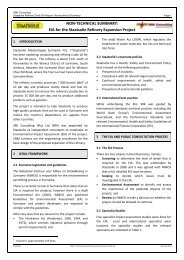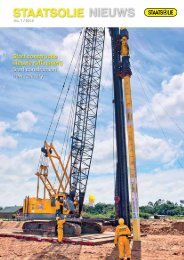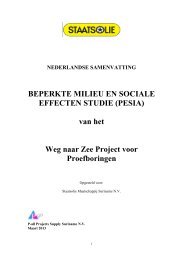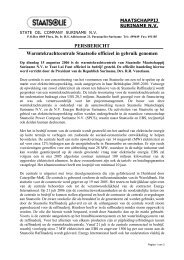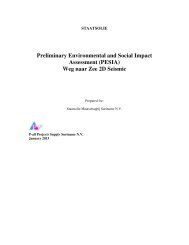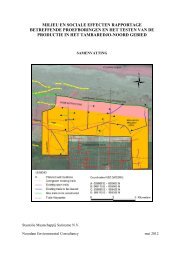concept EIA-rapport - Staatsolie
concept EIA-rapport - Staatsolie
concept EIA-rapport - Staatsolie
Create successful ePaper yourself
Turn your PDF publications into a flip-book with our unique Google optimized e-Paper software.
SRK Consulting: Project No: 439414 <strong>Staatsolie</strong> Pipeline <strong>EIA</strong> – Draft <strong>EIA</strong> Report Page 70<br />
pressure in the borehole. A frac-out is more likely to occur during the pilot drilling phase than during<br />
the reaming or pull-in phases.<br />
Impact if the incident occurs<br />
The northern-most entry point is located on land, near the Suritex property. Frac-outs on land are<br />
relatively easy to contain if containment structures (e.g. straw bales, silt fence or plastic sheeting)<br />
are available. Once contained, the escaped mud can be removed and is not expected to pose a<br />
danger to the environment.<br />
Four of the entry / exit points are located on the riverbank. Frac-outs in aquatic environments are<br />
very difficult to contain, because bentonite readily disperses in flowing water. Water-based<br />
(bentonite) drilling mud is generally not toxic, but could result in increased silt content in the<br />
immediate vicinity of the release point. The increased silt load could impact on the aquatic<br />
environment by e.g. smothering fish (by clogging their gills) and / or fish eggs and benthic organisms<br />
when the bentonite settles out (Sacramento Municipal Utility District, 2001).<br />
Should a frac-out occur, the impact will depend on the volume of mud that is released, which<br />
determines the extent of the plume and settlement patterns. However, given the size of the<br />
Suriname River and its dilution capacity, as well as the absence of sensitive habitats or species in<br />
this area, a frac-out that is quickly detected and dealt with is expected to have limited impacts on the<br />
overall system.<br />
The potential impact of an accidental release of drilling mud, should it occur, is rated to be of local<br />
extent (as the mud quickly disperses in the water) and medium intensity (as a large quantity of mud<br />
could be released). Duration is rated as short-term as the system is expected to restore itself after an<br />
incident. The impact is therefore assessed to be of low (negative) significance.<br />
The implementation of the recommended mitigation measures would reduce the likelihood of an<br />
incident (which is not reflected in the rating below) and the volume of mud released in the event of<br />
an accident, thereby reducing the intensity of the impact and the overall significance to very low<br />
(negative) (see Table 6-11).<br />
Table 6-11: Significance of frac-out, should this occur<br />
Extent Intensity Duration Consequence Probability Significance Status Confidence<br />
Without<br />
mitigation<br />
Local<br />
1<br />
Medium<br />
2<br />
Short-term<br />
1<br />
Low<br />
4<br />
Probable LOW -ve Medium<br />
Essential mitigation measures:<br />
To reduce the probability of an incident (does not affect significance rating):<br />
• Closely monitor drilling pressures and penetration rates. Ensure that mud pressure is optimal to penetrate the<br />
formation.<br />
To reduce the impact in the event of an incident:<br />
• Visually monitor the areas around the drilling site for signs of drilling mud leakage, especially while drilling<br />
shallower sections near the entry / exit points.<br />
• Compare the estimated and actual volume of drilling mud returns, to detect escaping mud.<br />
• Cease drilling operations if returns of drilling mud decrease or if a surface release of drilling mud is detected, to<br />
determine what actions need to be taken, in line with stipulations in the EMMP and the spill response plan.<br />
• Comply with any additional mitigation measures contained in the EMMP.<br />
With<br />
mitigation<br />
Local<br />
1<br />
Low<br />
1<br />
Short-term<br />
1<br />
Very Low<br />
3<br />
Probable VERY LOW -ve Medium<br />
6.7.2 Risk: Accidental release of hydrocarbons due to pipeline rupture or leakage<br />
The discussion below is largely based on the QRA undertaken for the <strong>Staatsolie</strong> Pipeline Project<br />
(Burger 2012) and contributions by Dirk Noordam.<br />
REUT/DALC 439414_<strong>Staatsolie</strong>Pipeline<strong>EIA</strong>_Draft <strong>EIA</strong> Report_Final June 2012




